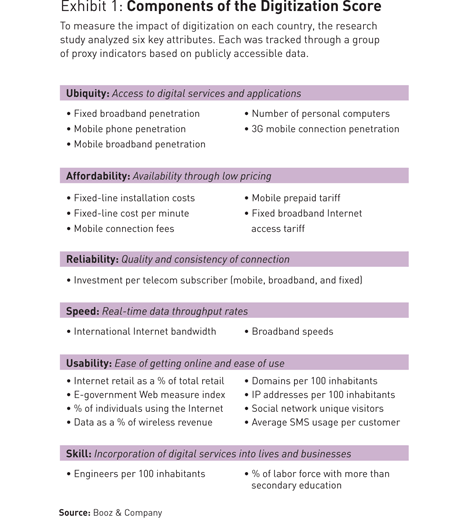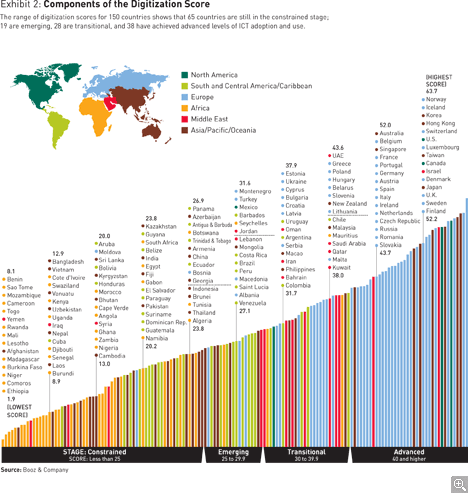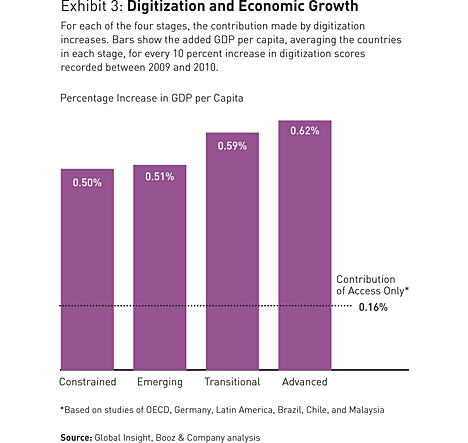Digitization and Prosperity
The economic growth of nations is linked to one factor: adoption of information and communications technology.
(originally published by Booz & Company)Policymakers today face an environment transformed by information and communications technology (ICT). More people today have access to a mobile phone than to electricity; the amount of data generated globally is expanding exponentially. In every country, leaders of government and business are deciding — through their policies and strategies for ICT, Internet access, communications media, and digital applications — how to promote and structure the digitization of their economies. These choices have enormous consequences. Countries that have achieved advanced levels of digitization, defined as the mass adoption of connected digital technologies and ICT applications by consumers, enterprises, and governments, have realized significant economic, social, and political benefits. For them, digitization is a pathway to prosperity. Other countries are falling disproportionately behind.
The difference among countries was a core finding of a recent study conducted by Booz & Company, “Maximizing the Impact of Digitization.” Other studies on ICT and prosperity have focused primarily on Internet access: whether people are able to connect to wireless and broadband technologies. But by looking more closely at the ways people use digital technologies and applications, we found that the greatest social and economic benefits depend on factors related to adoption and usage: such as pricing, reliability, speed, and ease of use. In any geography, these factors determine the level of digitization, which in turn has a proven impact on reducing unemployment, improving quality of life, and boosting citizens’ access to public services. Digitization allows governments to operate with greater transparency and efficiency, and it has a dramatic effect on economic growth, but not all at once. Countries at the most advanced stage of digitization derive 20 percent more in economic benefits than do those that are just beginning.
Policymakers have an important role to play in moving their countries toward advanced levels of digitization. In their approach to technology, they need to shift focus from access, toward adoption and usage. That means elevating digitization on the national agenda; tracking progress systematically; developing a better governance model for the telecom and information technology sectors; adopting an ecosystem perspective; enabling competition; and stimulating demand.
Measuring Digitization
In 1990, there were 100 million personal computers worldwide, 10 million mobile phone users, and less than 3 million people (about the population of Berlin) on the Internet. Most of them used dial-up modems. By 2010, there were 1.4 billion PCs, 5 billion mobile phone users, and an Internet population of 2 billion, about the size of India and China combined. Nearly all were connected with broadband or a handheld browser, and they were geographically and economically dispersed; more than half a billion people today connect online from Africa.
During most of the ICT sector’s development, its impact was measured in terms of connection: the number of people reached by telecommunications lines and thus with access to the Internet. But in a world of near-universal access, a new form of assessment is needed.
The extent of a country’s digitization can be measured across six key attributes: ubiquity (the level of access to digital services and applications), affordability (pricing), reliability (the quality of connection), speed (the rate of data throughput), usability (the ease with which people can get online and use applications available there), and skill (the ability of users to incorporate digital services into their lives and businesses). (See Exhibit 1.)
In studying the impact of digitization on prosperity, we have found measurable proxy indicators for all six of these attributes. Thus, the level of digitization can be scored for any country. The scores show that the progression of digitization proceeds in four similar stages in all geographies. (See Exhibit 2.)
• Constrained economies (those with a digitization score below 25) have barely begun to develop affordable Internet connections, often because they are held back by political factors or lagging economic development. Internet services remain expensive and limited in reach.
• Emerging economies (those with a score between 25 and 29.9) have achieved significant progress in providing affordable and widespread access. However, the reliability of services remains below par, capacity is limited, and usage is low.
• Transitional economies (those with a digitization score between 30 and 39.9) provide citizens with ubiquitous, affordable, and reasonably reliable services, and usage is expanding at a relatively rapid pace.
• Advanced economies (those with a score of 40 and higher) are in the most mature stage of digitization. These countries have a talent base that can take advantage of digital services.
For the world as a whole, the progression of digitization through these stages is accelerating. Developed countries such as Germany, the United Kingdom, and the United States took nearly four years on average to move from the emerging to the transitional stage; now, countries such as the United Arab Emirates, Kuwait, and Estonia are making that same move in less than two years. Between 2004 and 2007, countries registered 39 stage leaps; between 2007 and 2010, there were 65 stage leaps. From 2004 to 2007, countries moved, on average, seven points up the scale (of a total 100 points). From 2007 to 2010, the average jump was 10 points.
This acceleration stems from a number of factors. Emerging countries are following a path that developed nations have already blazed, learning from their successes and mistakes. Young economies can also take advantage of more mature technologies and markets, along with the corresponding price reductions. When skills are transferred to more countries and better governance structures are put in place, the implementation and usage of new technologies generally accelerate. Some emerging countries, like those in the Gulf Cooperation Council in the Middle East, are bypassing intermediate phases and jumping directly to higher levels of digitization.
Economic and Social Impact
The effect of digitization on a country’s economy is highly visible. In the 150 countries we studied, an increase in digitization of 10 percentage points triggered a 0.50 to 0.62 percent gain in per capita GDP. (See Exhibit 3.) By contrast, access (as measured in studies of broadband penetration) contributes a gain in per capita GDP of just 0.16 percent — approximately half as much impact. The more advanced the country, the greater the impact of digitization appears to be, which establishes a virtuous feedback cycle: A country reinforces and accelerates its own progress as it moves along the line. On the basis of data from 2009 and 2010, we estimate that the total global economic impact of digitization, in terms of added GDP, was US$395 billion per year. (It has, if anything, increased since then.)
Digitization also has a significant impact on job creation: A 10 percent increase in digitization reduces a nation’s unemployment rate by 0.84 percent. From 2009 to 2010, digitization added an estimated 19 million jobs to the global economy, up 5 percent from the estimated 18 million jobs added from 2007 to 2008. This is an especially critical finding for emerging markets, which will need to create hundreds of millions of jobs in the coming decade to ensure that a booming population of young people can contribute to their national economy. Finally, a 10-point increase in digitization has, on average, led to a six-point increase in the country’s score on the INSEAD Global Innovation Index, which ranks countries according to innovation potential. (See “The Innovativeness of Nations,” by Rob Norton, s+b, Spring 2012.) In other words, as a country progresses in its digitization development, it appears to become more innovative.
Assessing the social impact of digitization is more complicated because no metrics apply to all geographies in the same way. Many studies have tracked income disparity as a proxy for social inequality, using the Gini coefficient (a measure of statistical dispersion), but in emerging economies that are in the process of elevating millions of people out of poverty, the relationship between economic growth and inequality is complex. Therefore, we focused our study of the social impact of digitization on two measures: quality of life and equality of access to basic services. We used the widely published Gallup Wellbeing Index and the Organisation for Economic Co-operation and Development (OECD) Better Life Index to measure the former, and the United Nations Development Programme’s (UNDP’s) Human Development Index to measure the latter.
In developed economies, increasing digitization significantly boosts quality of life: OECD countries gain an average of 1.3 points on the Better Life Index for every 10-point increase in the digitization score. However, in countries with lower levels of economic development, the impact of digitization is less pronounced, most likely because quality-of-life factors beyond digitization — food, housing, clothing, water, energy, health, and transportation — are in shorter supply and thus more critical. In other words, digitization improves a country’s quality of life only when the basic needs of its population have been met.
Yet when we examine access to basic services, we see the opposite effect. Digitization’s impact is greatest in constrained and emerging economies. A 10-point increase in the digitization score leads to an increase of approximately 0.13 points in the Human Development Index. In more developed economies where basic human needs are more easily met, digitization plays a less pronounced role in expanding access to education, sanitation, water, and healthcare.
To assess government effectiveness, we used three metrics: the 2010 Corruption Perceptions Index published by Transparency International; the e-government development index created by the United Nations Public Administration Network to gauge the provision of electronic services by governments; and the Inequality-Adjusted Education Index, measured by the UNDP to show the extent of public education, a key government service. We found that greater digitization led to improvement on all three counts. Digitization enables a society to be more transparent, increasing public participation and the government’s ability to disseminate information effectively: A 10-point increase in digitization increases the Transparency International index by approximately 1.2 points. Digitization raises e-government effectiveness by approximately 0.1 points (and kick-starts another virtuous cycle, as greater e-government effectiveness accelerates digitization). And digitization gives the population more insight into government policies and functions, which might, in turn, lead to more active political participation and support the development of human rights.
Finally, digitization supports better delivery of public education and other government services. Here again, digitization’s impact is more pronounced in the case of developing countries, where a 10-point increase in digitization results in an average 0.17-point increase in the Inequality-Adjusted Education Index. This trend has less effect in developed countries because they already have greater access to universal basic education.
What Can Governments Do?
The digitization index can be an invaluable tool for countries seeking to advance their place in the world. Investment in broadband infrastructure has helped ensure widespread high-speed access to the Internet and communications services. But this investment is not enough. Nor is the next step to simply invest more money — even if the money is available. Instead, policymakers can play a pivotal role by focusing on five key imperatives.
1. Elevating digitization on the national agenda. To realize the wide-ranging benefits that digitization offers, countries need support from the highest levels of government. Every country, whatever its digitization maturity level, needs a national agenda, with oversight at the executive branch of government. Otherwise, the ICT sector can devolve into a “tragedy of the commons” in which too many competitive stakeholders, fighting to sell products and services online, impede progress. Some governments, especially those in the constrained and emerging stages, also need to change their approach to ICT-related taxation. They must stop viewing the sector as a source of tax revenue and recognize it instead as an enabler of socioeconomic development. Countries that have made this transition have been rewarded. In 2007, Qatar reduced the royalties paid by the telecommunications sector to the government. The resulting incentives for entrepreneurship have helped the ICT sector’s contribution to Qatar’s GDP grow by approximately 16 percent in the five years since. Qatar’s share of total ICT activity in the Middle East has doubled.
Governments can also elevate the digitization agenda by creating an effective system that measures, tracks, and demonstrates the impact of every dollar invested in it. Economies at all four stages of development are still developing and refining the relevant metrics. For example, the United States’ National Broadband Plan was approved by the Federal Communications Commission in 2010. It includes dozens of specific measures to improve regulations and standards, with six overarching goals: bringing high-speed Internet to 100 million more homes, providing leadership in mobile innovation, developing a more robust broadband network, ensuring more affordable broadband service, establishing nationwide wireless access for first responders, and enabling a clean energy economy.
2. Developing a better governance model. Governments play four complementary roles in fostering digitization. They set policy, regulate companies and activity, invest in developing the sector, and “e-enable” public services (bring them online, along with appropriate links to private-sector services). Each role is distinct but must be coordinated with the others. To ensure synergies and efficiencies, most countries place all four functions within a single organization, as the United Kingdom and Qatar have done.
The most effective governance structures involve open and appropriate collaboration among private companies and agency officials, through industry forums and policy consultations. (See “School Reform for Realists,” by Andrea Gabor.) The frameworks for public–private partnerships that can manage investments that are less immediately attractive should be clear. For example, governments may decide to fund broadband deployment in remote regions, but let the private sector target the urban areas.
Most developed countries have seen direct benefits from strong sector governance. Singapore, for example, executed its digitization plan in 2006, and its ICT sector had grown by 13.6 percent by 2008, due in part to the country’s robust governance. Developing countries can accelerate development of their ICT sectors by establishing a policymaking function and investing early in a sector-development arm. Saudi Arabia, for instance, advanced rapidly through the stages of digitization by ensuring fulfillment of all regulatory and oversight roles at the national level.
3. Adopting an ecosystem philosophy. It’s not possible to stop the convergence of the telecommunications, media, and technology industries, or the integration of the value chain, including infrastructure, applications, and usage. Even in relatively small countries, like Qatar, Singapore, and the Netherlands, ICT companies are looking beyond their local markets to expand their business. (See “The Global ICT 50: The Supply Side of Digitization,” by Olaf Acker, Florian Gröne, and Germar Schröder.) These changes in the technology and media ecosystem will mean abandoning or changing many established government practices.
For example, emerging economies have often abetted investment in telecommunications infrastructure, and as a result this sector is fairly well developed. In many of these countries, however, other kinds of information technology still lag. For instance, in the United Arab Emirates, non-telecommunications spending accounts for 21 percent of total ICT spending, compared with 37 percent in developed markets such as Finland; this means that the untapped ICT opportunity beyond telecommunications in emerging economies (for services such as enterprise computing) is significant.
Policymakers also need to foster local capabilities in creating content and applications. In Estonia, for example, innovative software and hardware companies have been in place since the 1990s; they contributed more than €500 million (US$473 million) in annual revenues by 2001, and have created more than 400,000 jobs overall. Their success encouraged Estonia to launch a development fund in 2007 to further develop its knowledge economy, investing in resources such as ICT parks and innovation centers, and setting up particular export-oriented projects, such as an “Estonia–India foresight project” with a concentration on cybersecurity.
National investment in ICT-related innovation capabilities can have lasting economic effect. In the mid-2000s, Egypt introduced ICT into its education system, developed e-content, created technology parks, encouraged the creation of small and midsized enterprises focused on ICT via developing technology incubators, and established the ICT Trust Fund, which uses digital technology to promote and enhance the performance of these enterprises. As a result, Egypt became one of the largest ICT exporters in the Middle East and North Africa region, with 27 percent yearly growth in ICT service exports from 2005 to 2009. Even during the country’s political upheaval, the number of ICT companies continued to grow, from about 4,000 in 2010 to 4,600 in 2012.
4. Enabling competition. Although telecommunications was a monopolistic business for most of the 20th century, the industry has learned the value of competition since the mid-1980s. Competitive provision of broadband and software infrastructure fosters innovation and drives adoption, two factors critical to enabling countries to progress in their digitization efforts.
In most emerging economies, market liberalization — through ICT license auctions, privatization of state-owned telecom and media companies, and deregulation of barriers to entry — has been a key mechanism in driving competition. In Saudi Arabia, for example, market liberalization began in the early 2000s, as state-owned Saudi Telecom prepared to compete openly in its home market for the first time, and to enter other markets. This liberalization led to a 9 percent annual growth rate in digitization between 2000 and 2004. The 2005 entry of another phone company, Etisalat, spurred heavy investment in fixed and mobile broadband, which, in turn, fueled 17 percent annual growth in digitization between 2005 and 2010.
In some cases, competition can backfire. In India, for example, excessive liberalization triggered aggressive competition and unsustainable returns for shareholders. To correct such a situation, policymakers should encourage consolidation that will restore balance to the sector. For example, in several countries, when competition inhibited investment in Internet infrastructure, policymakers created new “natural monopolies” to fill this role: regulated companies like OpenNet in Singapore, QNBN in Qatar, and National Broadband Network in Australia. In cases like these, regulators need to ensure that the monopolistic entity is well regulated and that there is significant service-level competition to spur innovation. Singapore, for example, created a regulatory framework that effectively gave OpenNet a monopoly in building and operating the country’s passive networks. This framework allows regulated returns on investment in infrastructure while ensuring competition in services. Similarly, in the United Kingdom, policymakers are encouraging consolidation of the infrastructure — as evidenced by the merger of Orange and T-Mobile — while maintaining a competitive environment in services.
5. Stimulating demand. Countries can progress rapidly in digitization by encouraging the adoption of new applications by individuals, businesses, and their own agencies. One way to stimulate demand is to ensure that citizens can perform all government-related tasks — such as paying taxes, renewing drivers’ licenses, and enrolling in school — using broadband networks.
Beyond that, demand for ICT services depends on technological literacy and skilled human capital. Policymakers can invest in digitization by providing training programs and incentives for education. They can also boost usage by promoting high-speed broadband services and ensuring that these networks are both widely available and affordable.
A number of countries in the advanced stage of digitization have learned how to raise demand. For instance, France has increased ICT spending at a yearly rate of 5 percent since 2003 through a number of initiatives. Among these are the creation of the Villes Internet association, which works with local authorities to develop Internet-literate citizens; and the Comité Interministériel pour la Société de l’Information, which was created to encourage Internet usage, improve public services via technological innovation, and strengthen the competitiveness of French companies.
The Digitization Imperative
For some policymakers, the statistics on digitization will be a wake-up call. The metrics will reveal gaps in a country’s capabilities — and ways in which it is not equipped to compete with other countries. Other policymakers will be pleased to see that they are relatively well prepared — but for how long?
The results also confirm a feeling that many policymakers share: that digitization can catalyze dramatic economic, social, and political improvements. Anecdotal evidence abounds: Water utilities have installed sensors that reduce leakage, saving water and money; healthcare organizations send text messages to pregnant women with advice on prenatal care, creating a healthier new generation even before it is born; fleets of delivery trucks use GPS devices to find shorter routes, cutting down on their greenhouse gas emissions. But until the impact is quantified, nobody quite knows how much to emphasize digitization, or how its impact compares to that of other factors. We hope this analysis can help demonstrate the high leverage that can accrue from investment in digitization beyond simple broadband access.
In his book The Shield of Achilles: War, Peace and the Course of History (Knopf, 2002), constitutional historian Philip Bobbitt argued that the world was going through a fundamental shift in the prevailing view of the purpose of government, from the 20th-century nation-state, which derived its legitimacy by guaranteeing the welfare of the nation’s people, to the 21st-century “market state,” which will focus on expanding opportunities for its citizens.
The embrace of digitization is, perhaps, an example of that shift. Indeed, nowhere are the benefits of the market state more evident than in ICT. National governments have learned that there are limits to their role as welfare guarantors. They cannot protect their citizens indefinitely against the vicissitudes of the global economy. But by advancing the cause of digitization, they can become market makers, building their own capabilities — and those of their citizens and businesses — to raise the level of opportunity for their entire population. ![]()
Reprint No. 00127
Author profiles:
- Bahjat El-Darwiche is a partner with Booz & Company in Beirut. He specializes in communications, media, and technology, with expertise in telecom-sector growth strategy, policymaking and regulatory management, digitization business and operating models, and strategy-based restructuring for ICT companies.
- Milind Singh is a principal with Booz & Company in Dubai. He focuses on sector policy and development strategy for the telecommunications and ICT industries.
- Sandeep Ganediwalla is an associate with Booz & Company in Dubai. He specializes in analysis, performance, and strategy for the telecommunications and ICT industries.
- Also contributing to this article were Booz & Company senior partner Karim Sabbagh and partner Roman Friedrich, along with Raul Katz of Telecom Advisory Services LLC.






